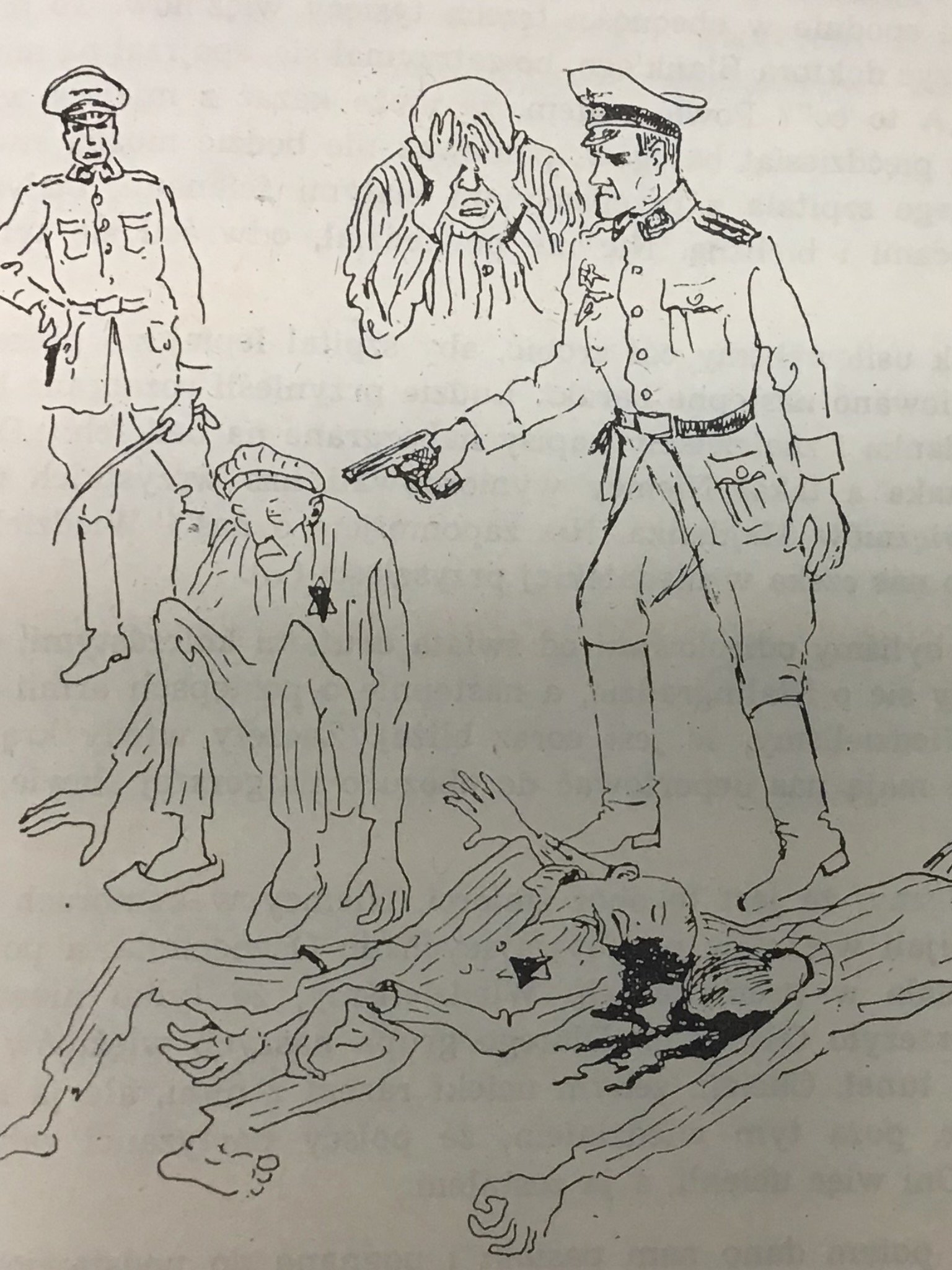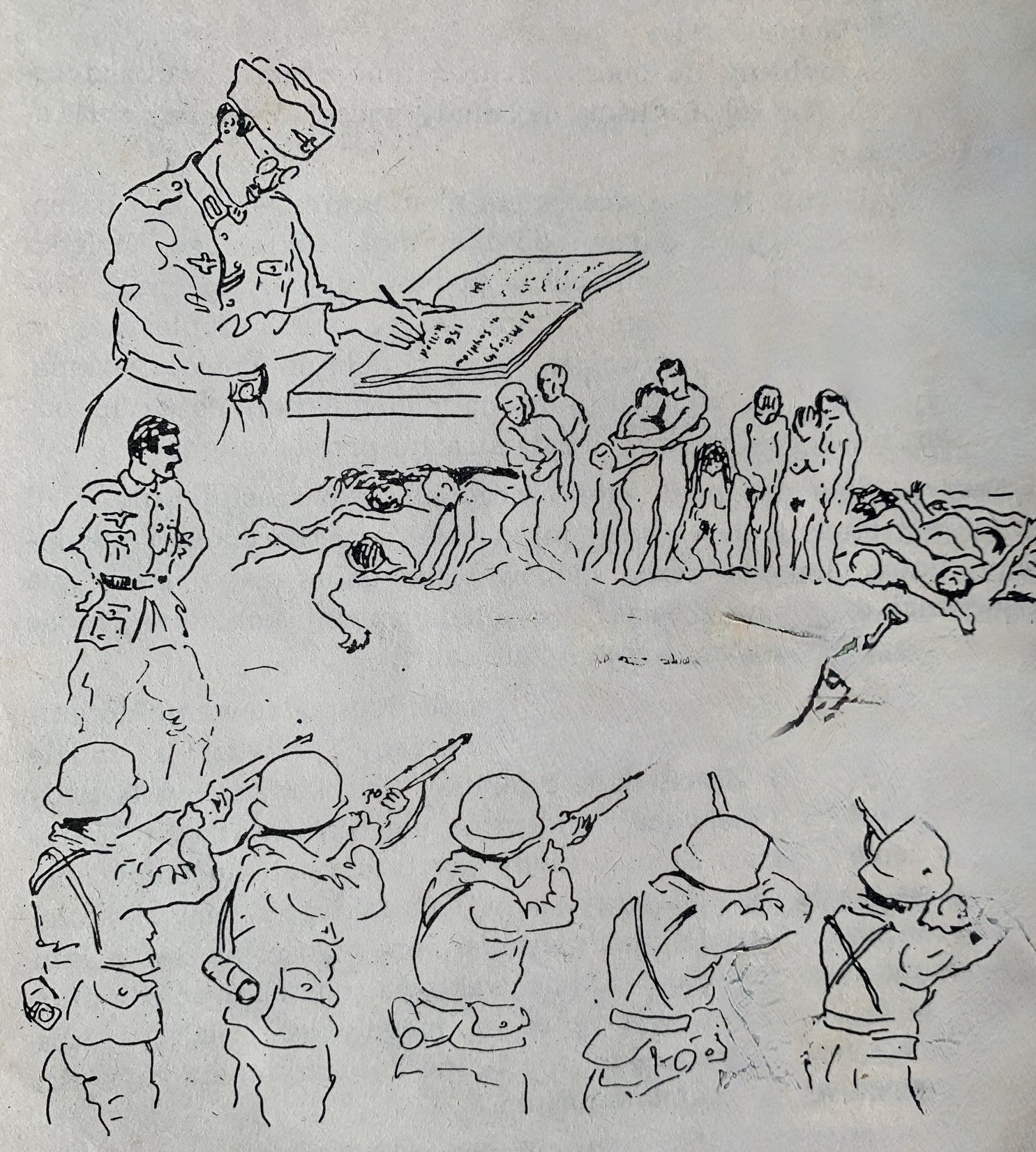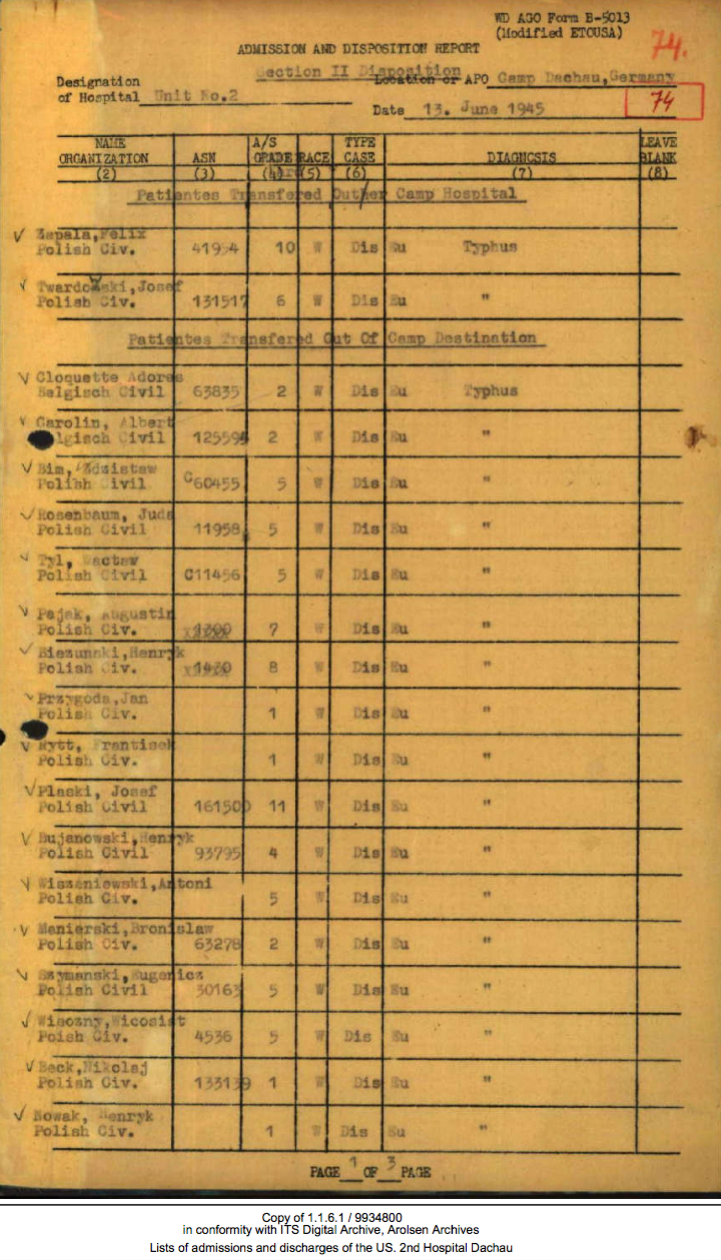The Concentration Camps
This section contains photographs and documents relevant to Henry’s incarceration in the Blizyn, Auschwitz and Dachau-Kaufering concentration camps.
Blizyn Concentration Camp 1943
Henry, Ignacy, Halina and her family and the other surviving Jews from the Tomaszow Small Ghetto were transported to Blizyn in May 1943 on completion of the clearing out of the Tomaszow Ghetto. This map marks the camp perimeter, the Kamienna River dividing the camp with the upper camp for Germans and guards closer to the road and black and white marked railway line. The lower camp for Jewish prisoners and workshops has diagonal marking.
(I was a Prisoner at the Blizyn Concentration Camp by Dawid Wainapel.( Company of Friends of Blizyn 1990 ))
Blizyn Concentration camp site 1997
The camp site is now occupied by factories. This fence shows remnants of the concentration camp fencing which are the curved concrete posts which carried the barbed wire fence.
Blizyn Concentration camp; depiction of scene with a guard dog.
[I was a Prisoner at the Blizyn Concentration Camp by Dawid Wainapel.
( Company of Friends of Blizyn 1990 )]
Execution Blizyn Concentration Camp
A sketch depicting an execution at Blizyn from the booklet;
(I was a Prisoner at the Blizyn Concentration Camp by Dawid Wainapel.( Company of Friends of Blizyn 1990 )
Firing Squad Execution,
Blizyn Concentration Camp
A sketch depicting an execution in the camp.
(I was a Prisoner at the Blizyn Concentration Camp by Dawid Wainapel.( Company of Friends of Blizyn 1990 ))
Dr Dawid Wainapel
Dawid Wainapel was the Jewish doctor from Radom, who ran the medical clinic in the Blizyn camp. He wrote the book ‘ From Death Row to Freedom’, about his Holocaust experience. He makes reference to Henry, the medical student from Montpellier, in his book and was a medical role model for Henry.
(I was a Prisoner at the Blizyn Concentration Camp by Dawid Wainapel. [Company of Friends of Blizyn 1990])
Auschwitz, July 31 1944
Entry from the Auschwitz archives for 31 July 1944 showing arrival of Jewish prisoners from Blizyn. Henry’s tattooed number B-1224 is within the range indicated in this entry. (Auschwitz Chronicle)
Gas Chamber, Auschwitz
This is the entrance stairs down to the undressing room. The roof has been destroyed by the SS as they tried to demolish the gas chambers prior to their retreat. However the basic structure of the facility is there for all to see. The gas chamber itself adjoins to the right side of the undressing room and the remains of the crematorium can be seen at the far end of the room.
Gas Chamber, Auschwitz
This is the gas chamber which lay perpendicular to the undressing room. The roof has been collapsed into the chamber by the attempted demolition of the facility by the retreating Nazis. The gas chamber could hold 2,000 victims who would be killed with cyanide gas over about 15 minutes.
Dachau/ Kaufering,
October 27 1944
Henry’s registration document at Dachau on his way to the Kaufering sub-camp. The ‘R’ is missing from Bierzynski and Halina is missing the ‘H’ but that is Henry’s signature at the bottom. ( Arolsen Archive)
Weingut II Kaufering 1944
A diagram of the subsurface, partially buried concrete jet aircraft factory where Henry worked as one of 23,000 slave labourers from October 1944 until liberation in late April 1945. The structure was built by the Moll company and consisted of a shaped gravel semicylindrical mound over which a steel reinforced concrete shell was poured. The gravel was then excavated out using the tunnel and rail cars and was then covered with gravel and soil before being covered by vegetation. The 5 storey factory built Messerschmidt 262 jet aircraft.
(Wikimedia Commons)
Weingut 2 Kaufering Bavaria
1944-45
Side view of the structure
(photo album of site manager OT Rudolf Neuhaus)
Weingut 2, Kaufering, Bavaria
1944-45
Front view of the structure.
(photo album of site manager OT Rudolf Neuhaus)
Weingut 2, Kaufering , Bavaria , 1944-45
View of one end of the building giving an idea of it’s size.
(photo album of site manager OT Rudolf Neuhaus)
Henry’s ‘blue striped pyjamas’
After liberation in Kaufering, inmates were given US army uniforms and concentration camp uniforms were burned.
Henry had changed already and as an afterthought grabbed this uniform as a memento from the pile being burned. It was not his uniform in the camp.
Landsberg, Germany 1945
Henry’s business card while camp secretary at the Landsberg Displaced Persons Camp. The card carries the various concentration camp numbers he carried throughout the war.
US Army Hospital Landsberg 1945
Document listing Henry’s admission to 116 Evacuation Hospital, Landsberg with Typhus fever.
31 May 1945 . (Arolsen Archive)
US Army Hospital Unit No 2
Document with listing Henry’s discharge from hospital after his admission with Typhus.
13 June 1945. (Arolsen Archive)
German Restitution document 1956
This document, issued by the Mainz Government District Office for Compensation and Managed Assets, acknowledges and lists Henry’s periods of incarceration
Jan 1940-Dec 1940 was for having to wear the Star of David
Dec 1940-Nov 1942 was for the Tomaszow ghetto
The Auschwitz Archive shows Henry arrived in Auschwitz in July 1944 and not May. 1944, a 2 month difference.
German Restitution document 1956 continued
This shows the total number of months Henry was in captivity during the Holocaust; a total of 52 months for which he was compensated 112.50 Deutsch marks/month totalling DM 5850
This map shows Henry’s journey throughout the war and Halina’s death March in January 1945
The Ghost Tattoo
About The Ghost Tattoo
To the outside world, Henry Bernard was a hard-working and beloved family doctor on Sydney's Northern Beaches. Yet he was also a Holocaust survivor whose life was profoundly affected by the experiences of his past. He took extreme steps for his family's security, keeping a rifle near his bedroom and covering up his family's Jewish origin. He was obsessed with paying off debt - the German word for debt being the same as the word for 'guilt'. He kept his striped Auschwitz uniform with a picture of his mother in his wardrobe. These obsessions helped destroy his marriage and restricted any hope he had of conventional domestic happiness.
But Henry had a bigger secret and a deeper shame about what he had done during the war. He suffered privately until he began returning to Germany and Poland to confront his past and come to terms with the deaths of his parents and of Halina, the love of his life.
The Ghost Tattoo is the story of how Tony Bernard, Henry's eldest son, went on a forty-year journey with his father to solve the mystery of why Henry was the way he was, and how he finally came to understand the desperate choices Henry had made in the ghetto to try to keep himself and his family alive.



























